Note: This website was automatically translated, so some terms or nuances may not be completely accurate.
The Only Company in the World Challenging Space Debris: A Japanese Venture

Mitsunobu Okada
ASTROSCALE PTE. LTD.

Tomoyasu Katagai
Dentsu Inc.
[Understand in 30 Seconds] The Space Debris Problem
Space is no longer just a stage for dreams; it has transformed into a business field. Here, we visit Japanese space ventures to explore how space can be utilized by the private sector.
This time, Dentsu Inc.'s Tomoyasu Katagai interviews Mitsunobu Okada, CEO of Astroscale—the world's first company tackling space debris. What exactly is space debris? How does it impact our lives?
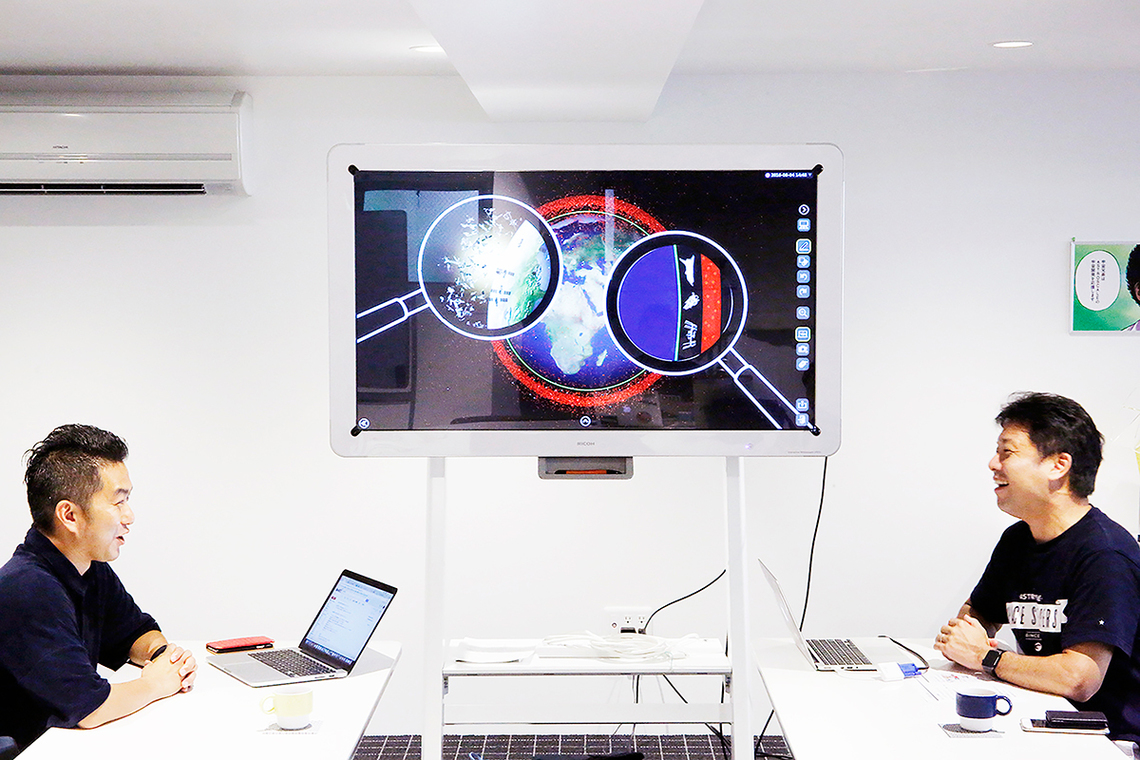
AstroScale CEO Mr. Okada (right) and Dentsu Inc.'s Mr. Katakai (left)
Space is filled with debris as large as a bus
Katakai: A few years ago, I saw news about a satellite being destroyed by space debris shortly after launch. At the time, I couldn't quite picture what this space junk actually looked like.
Okada: Space is actually full of debris. Currently, there are about 1,400 satellites orbiting Earth. Meanwhile, there are over 23,000 pieces of debris larger than 10 centimeters. Smaller debris can't be seen by ground-based radar, so the exact number is unknown, but estimates range from 100 million to 1 trillion pieces.
Debris ultimately originates from the remains of satellites, rockets, and other objects. Some pieces are as large as a bus.
It's traveling through space at 7 to 8 kilometers per second. To put that in perspective, it's fast enough to cover the distance between Tokyo and Osaka in just one minute—about 20 times the speed of a bullet. If you collide with large debris, you're done for.
Katagai: It's like a weapon in space.
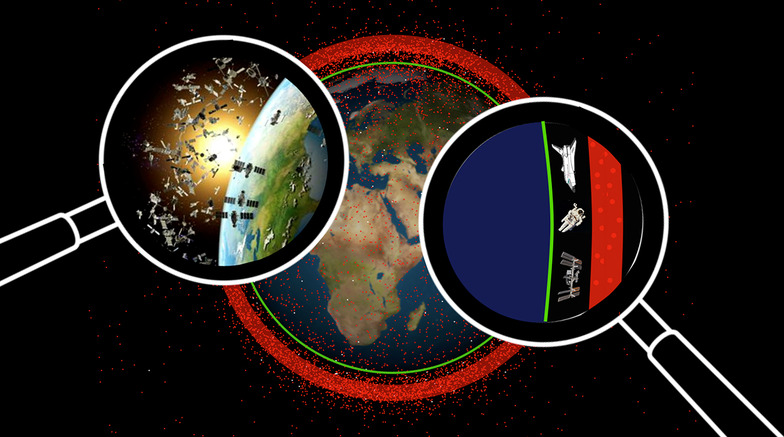
Green areas represent the Earth's surface; red areas show debris. Debris is most concentrated at altitudes between 600 and 1000 kilometers. The last time humans ventured beyond this zone was in 1972, during the Apollo 17 lunar landing. ©ASTROSCALE
Okada: Debris has long been one of the challenges facing the space industry. However, because space is incredibly vast, while near misses occur, actual collisions are extremely rare.
However, the 2009 collision between American and Russian satellites became the catalyst, making it clear we must finally address this situation.
This accident created new debris from the satellite wreckage, rapidly increasing the total amount. If debris collides with other debris, the numbers will only grow further. We need to remove the larger pieces before they shatter into smaller fragments to prevent chain collisions.
Katagai: What kind of problems does space debris cause on Earth?
Okada: We benefit from space technology in countless aspects of daily life. For familiar examples, satellite TV, weather forecasts, and GPS information all come from satellites. Satellite observation data is utilized in virtually every scenario, from shipping and aviation to managing agriculture and fisheries.
If debris is left unchecked, it's said space could become unusable as soon as 30 years from now. Without satellites, we might not be able to sustain our current way of life.

If no one else will do it, I will. The driving force is a childhood dream.
Katagai: Astroscale is the only company in the world tackling debris removal. Before founding the company, Mr. Okada was active in a different industry. Why space business?
Okada: I've loved space since I was a child. At 15, I participated in NASA's astronaut experience program and had the opportunity to meet Mamoru Mohri.
After that, I worked in various businesses, but my passion for space always remained somewhere in my heart. Then, learning about the current state where the debris problem remains unsolved, I felt I had to do something about it myself. That encounter with Mr. Mouri back then can be said to be the origin of who I am today.
Regarding debris removal, I have another goal. Someday, regular flights will operate between Earth and the Moon, allowing people to freely travel through space. Before that happens, I want to remove the debris and create an environment where shuttles can navigate safely.
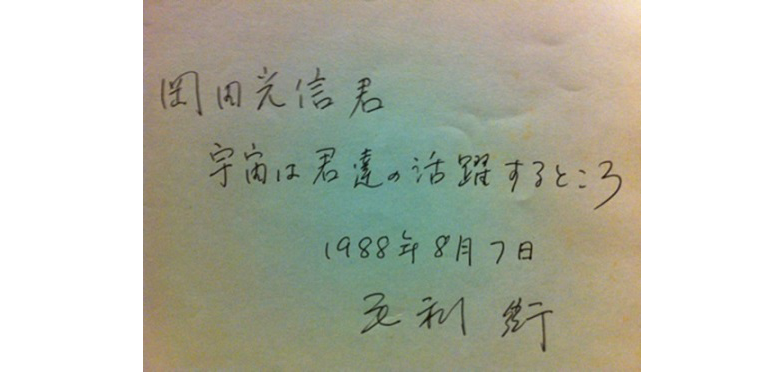
The handwritten message Mr. Okada received from Mr. Mouri at age 15: "Space is where you will shine." Astroscale's endeavors seem to embody this very sentiment.
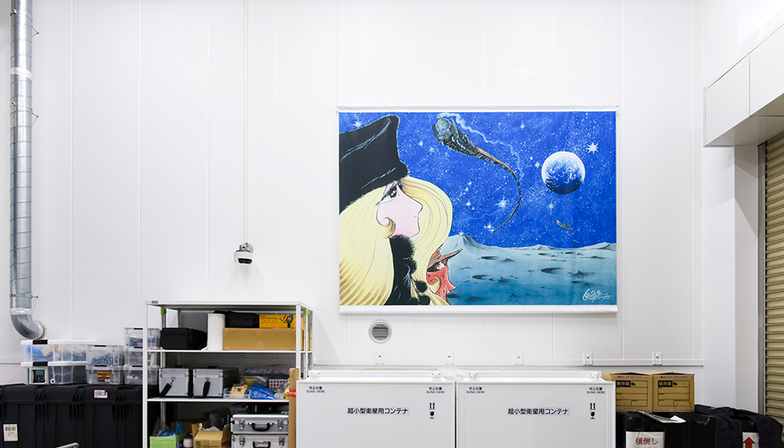
Inside ASTROSCALE's factory, a work gifted by Leiji Matsumoto is displayed. The image of a train racing through space, traveling between Earth and the cosmos, is the very embodiment of Okada's dream. ©Leiji Matsumoto ©ASTROSCALE
Capturing debris with adhesive and bringing it back to Earth's atmosphere
Katagai: How exactly do you plan to remove the debris?
Okada: We explored various methods: grabbing debris with a robotic arm, deploying nets like a fishing net, or harpooning it.
Ultimately, we adopted the method of sticking it with an adhesive like flypaper and built a capture satellite equipped with a lightweight adhesive usable in space. We pooled the technological capabilities of dozens of Japanese small and medium-sized enterprises, and the core adhesive itself is an original developed in collaboration with a domestic company.
One reason for choosing an adhesive was weight. Increased weight directly raises costs. The adhesive weighs only about 200 grams. A robotic arm weighs roughly 50 kilograms, so the difference is stark.
It's said that removing just a few hundred pieces of debris out of the estimated 23,000 pieces could help maintain the space environment. Reducing the cost per capture satellite would also make mass production easier, allowing us to launch more satellites into space.
Katagai: How about performance? The adhesive itself seems to offer unique advantages.
Okada: In space, if a robotic arm or harpoon fails to capture debris on the first attempt, the recoil from impact causes it to float away. Although overseas institutions had already begun preliminary research on net capture methods, they hadn't been realized.
With an adhesive, as long as it hits anywhere, it sticks, so the failure rate is significantly lower. After capturing the debris, we lower its altitude and re-enter the atmosphere to burn it up through friction.
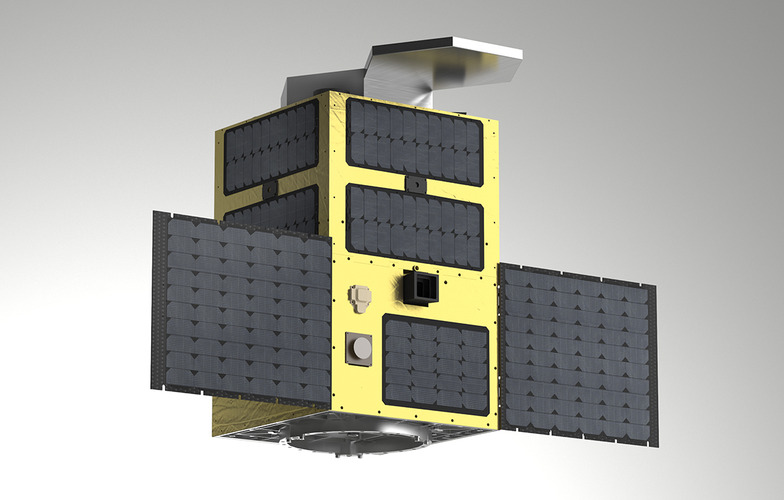
The capture satellite "ADRAS 1," scheduled for launch in 2018. ©ASTROSCALE
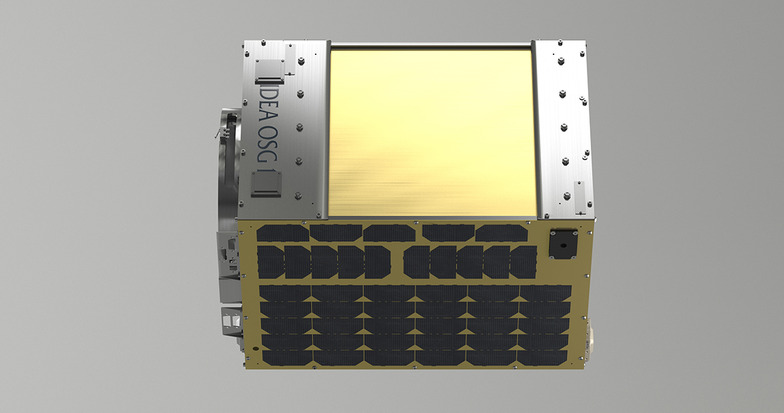
The "IDEA OSG 1" satellite is also being developed to detect tiny debris (0.1 to several millimeters) invisible from the ground. This satellite is scheduled for launch by early 2017 to research the distribution of micro-debris. ©ASTROSCALE
Connecting clients and space ventures on the moon
Katagai: The connection between ASTROSCALE and Dentsu Inc. began with the " Luna Dream Capsule Project," which involved Dentsu Inc.'s affiliate company, Drill Inc.

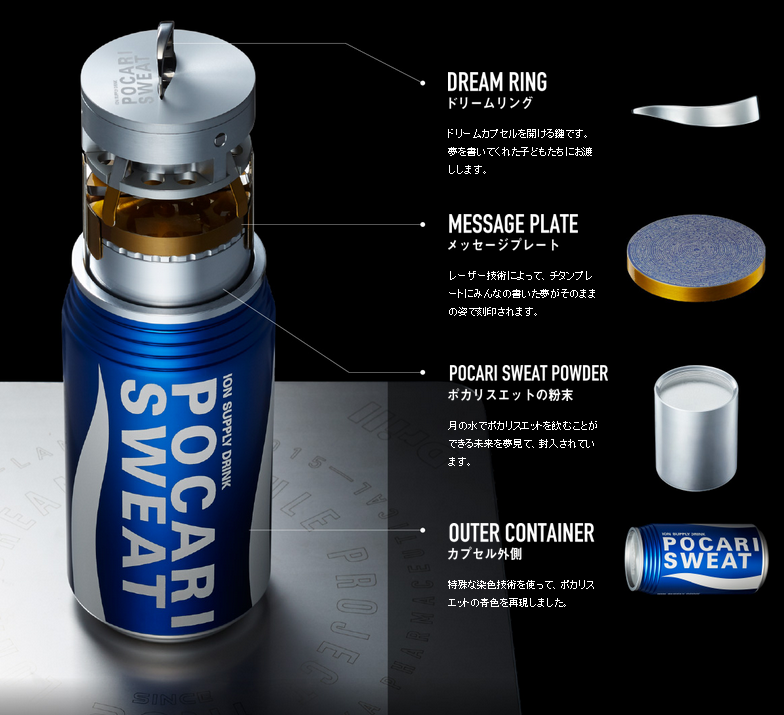
The "Luna Dream Capsule Project" aims to send the world's first beverage to the lunar surface. Under the concept "Let's deliver your dreams to the moon," it stores message plates engraved with the dreams of child crew members inside a capsule shaped like a Pocari Sweat can. This capsule will be sent to the moon aboard a lunar lander. The capsule also contains POCARI SWEAT powder, embodying the hope that someday, a crew member will land on the moon, discover this capsule, and taste its contents with lunar water. It received the Prime Minister's Award at the 2015 Kids Design Awards.
Katagai: Originally, myself and members of Drill Inc. joined to support Mr. Okada's efforts to reach the moon. Around that time, our sales team heard about a beverage manufacturer called Orien.
Initially, the order had nothing to do with the moon or space, but upon closer consideration, we realized the company's goals actually aligned with Mr. Okada's lunar ambitions.
News of lunar water discovery had just surfaced. We imagined how thrilling it would be to drink water from the moon, how we could deliver children's dreams to the moon, and how moving it would be when those children someday landed on the moon and reunited with those dreams.
We proposed this story to the company, and that's how this project began.
Okada: That's right. Being part of this project means we can achieve our goal of reaching the moon. This time, we were involved in producing elements like the Dream Capsule that carries the dreams and the design of the message plate. But another theme for us is removing space debris by that day, ensuring the children who participated can safely reach the moon.
Frankly, our efforts to communicate space to the general public feel like stirring a huge pot of miso soup with a tiny spoon—that's about the impact we have.
To truly stir it properly, we need large-scale projects and events that reach the general public—exactly the kind of "translation" work Dentsu Inc. is doing.
Katagai: We also feel we've proven that collaborating with space ventures is a viable way to solve client challenges. And I think Dentsu Inc.'s strength lies in being able to serve as that hub.

The "Pocari Sweat Run 2016," where Astroscale is the Official Space Partner. This year marks the fifth event held in Singapore. Over these five years, the total distance run by participants has exceeded 380,000 kilometers—the distance from Earth to the Moon.
A leap forward that even Harvard Business School is watching
Katagai: So far, we've mainly discussed domestic initiatives and reactions. Have there been any responses from overseas?
Okada: In 2015, our company was featured as a case study in Harvard Business School's curriculum. While Japanese companies have appeared before, they were always globally renowned large corporations. This was the first time a venture company like ours was highlighted.
I understand they specifically wanted to feature a key player in the space business. The actual case study began with explaining what space debris is, then covered the current state of the space industry regarding debris, our technological capabilities, and our strategy.
Katagai: Even though the space business is gaining momentum, it's still very much in a transitional phase. The fact that it's now being introduced as a business case at a world-class educational institution suggests the space industry is poised for even greater growth.
Okada: I believe the space-related dreams we've held until now will start becoming reality one after another. It's easier to understand if you compare it to the aviation industry: until the Wright brothers succeeded in the first manned flight in 1903, it was thought impossible for humans to fly.
After that, in less than half a century, aviation technology became established, and people could travel overseas by plane. The same thing should happen in the space industry.
Katagai: The day when people travel between space and Earth is not far off. Considering this, debris removal will become increasingly important within the space industry. We at Dentsu Inc. also aim to drive social action through space-focused projects and energize the space industry.

Was this article helpful?
Newsletter registration is here
We select and publish important news every day
For inquiries about this article
Author

Mitsunobu Okada
ASTROSCALE PTE. LTD.
CEO
Born in 1973 in Hyogo Prefecture. Resides in Singapore. Graduated from the Faculty of Agriculture, University of Tokyo. After working at the Ministry of Finance (now Ministry of Finance), management consulting, and IT companies, founded ASTROSCALE PTE. LTD. in 2013, the world's first company dedicated to solving space debris problems, and established ASTROSCALE in Tokyo in 2015. Also launched "MIKAWAYA21," a service supporting the needs of the elderly.

Tomoyasu Katagai
Dentsu Inc.
Business Transformation Division
Developed buzzworthy campaigns with a cohesive narrative from strategy to execution. Joined Drill Inc. in 2012 to expand my scope of activities. Currently in my current role since 2019. Producer providing solutions to social issues. Recipient of numerous advertising awards.
